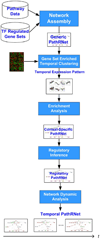Robust inference of the context specific structure and temporal dynamics of gene regulatory network
- PMID: 21143778
- PMCID: PMC2999341
- DOI: 10.1186/1471-2164-11-S3-S11
Robust inference of the context specific structure and temporal dynamics of gene regulatory network
Abstract
Background: Response of cells to changing endogenous or exogenous conditions is governed by intricate molecular interactions, or regulatory networks. To lead to appropriate responses, regulatory network should be 1) context-specific, i.e., its constituents and topology depend on the phonotypical and experimental context including tissue types and cell conditions, such as damage, stress, macroenvironments of cell, etc. and 2) time varying, i.e., network elements and their regulatory roles change actively over time to control the endogenous cell states e.g. different stages in a cell cycle.
Results: A novel network model PathRNet and a reconstruction approach PATTERN are proposed for reconstructing the context specific time varying regulatory networks by integrating microarray gene expression profiles and existing knowledge of pathways and transcription factors. The nodes of the PathRNet are Transcription Factors (TFs) and pathways, and edges represent the regulation between pathways and TFs. The reconstructed PathRNet for Kaposi's sarcoma-associated herpesvirus infection of human endothelial cells reveals the complicated dynamics of the underlying regulatory mechanisms that govern this intricate process. All the related materials including source code are available at http://compgenomics.utsa.edu/tvnet.html.
Conclusions: The proposed PathRNet provides a system level landscape of the dynamics of gene regulatory circuitry. The inference approach PATTERN enables robust reconstruction of the temporal dynamics of pathway-centric regulatory networks. The proposed approach for the first time provides a dynamic perspective of pathway, TF regulations, and their interaction related to specific endogenous and exogenous conditions.
Figures





















Similar articles
-
MICRAT: a novel algorithm for inferring gene regulatory networks using time series gene expression data.BMC Syst Biol. 2018 Dec 14;12(Suppl 7):115. doi: 10.1186/s12918-018-0635-1. BMC Syst Biol. 2018. PMID: 30547796 Free PMC article.
-
TF-finder: a software package for identifying transcription factors involved in biological processes using microarray data and existing knowledge base.BMC Bioinformatics. 2010 Aug 12;11:425. doi: 10.1186/1471-2105-11-425. BMC Bioinformatics. 2010. PMID: 20704747 Free PMC article.
-
Biological Network Inference and analysis using SEBINI and CABIN.Methods Mol Biol. 2009;541:551-76. doi: 10.1007/978-1-59745-243-4_24. Methods Mol Biol. 2009. PMID: 19381531 Review.
-
Trimming of mammalian transcriptional networks using network component analysis.BMC Bioinformatics. 2010 Oct 13;11:511. doi: 10.1186/1471-2105-11-511. BMC Bioinformatics. 2010. PMID: 20942926 Free PMC article.
-
Reconstructing the transcription regulatory network to optimize resource allocation for robust biosynthesis.Trends Biotechnol. 2022 Jun;40(6):735-751. doi: 10.1016/j.tibtech.2021.11.002. Epub 2021 Dec 9. Trends Biotechnol. 2022. PMID: 34895933 Review.
Cited by
-
Reverse engineering sparse gene regulatory networks using cubature kalman filter and compressed sensing.Adv Bioinformatics. 2013;2013:205763. doi: 10.1155/2013/205763. Epub 2013 May 8. Adv Bioinformatics. 2013. PMID: 23737768 Free PMC article.
-
2K09 and thereafter : the coming era of integrative bioinformatics, systems biology and intelligent computing for functional genomics and personalized medicine research.BMC Genomics. 2010 Dec 1;11 Suppl 3(Suppl 3):I1. doi: 10.1186/1471-2164-11-S3-I1. BMC Genomics. 2010. PMID: 21143775 Free PMC article.
References
-
- Van Someren EP, Wessels LF, Backer E, Reinders MJ. "Genetic network modeling,". Pharmacogenomics. 2002;vol. 3:pp. 507–25. - PubMed
-
- Shmulevich I, Dougherty ER, Kim S, Zhang W. "Probabilistic Boolean Networks: a rule-based uncertainty model for gene regulatory networks,". Bioinformatics. 2002;vol. 18:pp. 261–74. - PubMed
Publication types
MeSH terms
Substances
Grants and funding
LinkOut - more resources
Full Text Sources
Miscellaneous

